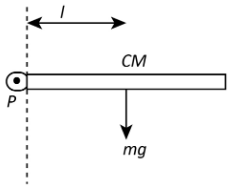
The distance between the point of suspension and the centre of gravity of a compound pendulum is $l$ and the radius of gyration about the horizontal axis through the centre of gravity is $k$, then its time period will be
A. $2\pi \sqrt {\dfrac{{l + k}}{g}} $
B. $2\pi \sqrt {\dfrac{{{l^2} + {k^2}}}{{lg}}} $
C. $2\pi \sqrt {\dfrac{{l + {k^2}}}{g}} $
D. $2\pi \sqrt {\dfrac{{2k}}{{lg}}} $
Answer
442.8k+ views
Hint:Obtain the equation of torque about point of suspension in terms of angular acceleration and momentum of inertia and it is also equal to force and perpendicular distance. Equation the equation obtained with general equation of motion, $\dfrac{{{d^2}\theta }}{{d{t^2}}} + {\omega ^2}\theta = 0$ where, $\dfrac{{{d^2}\theta }}{{d{t^2}}}$ is angular acceleration, $\theta $ is angular displacement and $\omega $ is the angular velocity.
Complete step by step answer:
From the given question, we know that the distance between the point of suspension (joint) and centre of gravity is $l$ and the radius of gyration is $k$. Let us consider the mass of the pendulum to be$m$. The figure below represents the pendulum at the horizontal position.

Let us obtain the torque about the point of suspension, the expression will be,
$
T = \alpha {I_P}\\
T = \dfrac{{{d^2}\theta }}{{d{t^2}}}{I_P}
$ ... (i)
Here, $\alpha $ is the angular acceleration, $\theta $ is the angular displacement and ${I_P}$ is the moment of inertia about point $P$.
We know that the torque about the point of suspension can be written as,
$T = - mgl\sin \theta $
Here, $g$ is the acceleration due to gravity.
Substitute the expression in the above equation (i).
$
- mgl\sin \theta = \dfrac{{{d^2}\theta }}{{d{t^2}}}{I_P}\\
\Rightarrow\dfrac{{{d^2}\theta }}{{d{t^2}}} + \dfrac{{mgl}}{{{I_P}}}\sin \theta = 0
$
For small angle, $\sin \theta \approx \theta $, the above equation becomes,
$\dfrac{{{d^2}\theta }}{{d{t^2}}} + \dfrac{{mgl}}{{{I_P}}}\theta = 0$
On comparing with the general equation of motion, $\dfrac{{{d^2}\theta }}{{d{t^2}}} + {\omega ^2}\theta = 0$, we have,
$\omega = \sqrt {\dfrac{{mgI}}{{{I_P}}}} $
The moment of inertia about point P by using parallel axis theorem is,
$
{I_P} = {I_{CM}} + m{l^2}\\
\Rightarrow{I_P} = m{k^2} + m{l^2}
$
The time period of the pendulum is expression as,
$T = \dfrac{{2\pi }}{\omega }$
Substitute the expression in the given equation.
\[
T = \dfrac{{2\pi }}{{\sqrt {\dfrac{{mgl}}{{m{k^2} + m{l^2}}}} }}\\
\therefore T = 2\pi \sqrt {\dfrac{{{k^2} + {l^2}}}{{gl}}}
\]
Thus, option C is correct.
Note:You should substitute the expression of moment of inertia at the point of suspension, not at the center of gravity because the torque is obtained at the point of suspension. Moment of inertia at point P can be obtained by using parallel axis theorem.According to this theorem, the moment of inertia at a point is equal to the sum of moment of inertia at CG and the product of mass and length between CG and that point.
Complete step by step answer:
From the given question, we know that the distance between the point of suspension (joint) and centre of gravity is $l$ and the radius of gyration is $k$. Let us consider the mass of the pendulum to be$m$. The figure below represents the pendulum at the horizontal position.

Let us obtain the torque about the point of suspension, the expression will be,
$
T = \alpha {I_P}\\
T = \dfrac{{{d^2}\theta }}{{d{t^2}}}{I_P}
$ ... (i)
Here, $\alpha $ is the angular acceleration, $\theta $ is the angular displacement and ${I_P}$ is the moment of inertia about point $P$.
We know that the torque about the point of suspension can be written as,
$T = - mgl\sin \theta $
Here, $g$ is the acceleration due to gravity.
Substitute the expression in the above equation (i).
$
- mgl\sin \theta = \dfrac{{{d^2}\theta }}{{d{t^2}}}{I_P}\\
\Rightarrow\dfrac{{{d^2}\theta }}{{d{t^2}}} + \dfrac{{mgl}}{{{I_P}}}\sin \theta = 0
$
For small angle, $\sin \theta \approx \theta $, the above equation becomes,
$\dfrac{{{d^2}\theta }}{{d{t^2}}} + \dfrac{{mgl}}{{{I_P}}}\theta = 0$
On comparing with the general equation of motion, $\dfrac{{{d^2}\theta }}{{d{t^2}}} + {\omega ^2}\theta = 0$, we have,
$\omega = \sqrt {\dfrac{{mgI}}{{{I_P}}}} $
The moment of inertia about point P by using parallel axis theorem is,
$
{I_P} = {I_{CM}} + m{l^2}\\
\Rightarrow{I_P} = m{k^2} + m{l^2}
$
The time period of the pendulum is expression as,
$T = \dfrac{{2\pi }}{\omega }$
Substitute the expression in the given equation.
\[
T = \dfrac{{2\pi }}{{\sqrt {\dfrac{{mgl}}{{m{k^2} + m{l^2}}}} }}\\
\therefore T = 2\pi \sqrt {\dfrac{{{k^2} + {l^2}}}{{gl}}}
\]
Thus, option C is correct.
Note:You should substitute the expression of moment of inertia at the point of suspension, not at the center of gravity because the torque is obtained at the point of suspension. Moment of inertia at point P can be obtained by using parallel axis theorem.According to this theorem, the moment of inertia at a point is equal to the sum of moment of inertia at CG and the product of mass and length between CG and that point.
Recently Updated Pages
Glucose when reduced with HI and red Phosphorus gives class 11 chemistry CBSE

The highest possible oxidation states of Uranium and class 11 chemistry CBSE

Find the value of x if the mode of the following data class 11 maths CBSE

Which of the following can be used in the Friedel Crafts class 11 chemistry CBSE

A sphere of mass 40 kg is attracted by a second sphere class 11 physics CBSE

Statement I Reactivity of aluminium decreases when class 11 chemistry CBSE

Trending doubts
10 examples of friction in our daily life

The correct order of melting point of 14th group elements class 11 chemistry CBSE

Difference Between Prokaryotic Cells and Eukaryotic Cells

One Metric ton is equal to kg A 10000 B 1000 C 100 class 11 physics CBSE

State and prove Bernoullis theorem class 11 physics CBSE

What organs are located on the left side of your body class 11 biology CBSE




